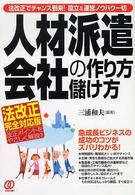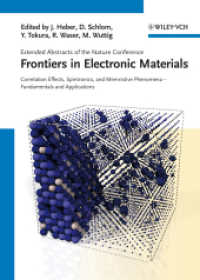- ホーム
- > 洋書
- > 英文書
- > Cinema / Film
Full Description
The burgeoning scholarship on Western health films stands in stark contrast to the vacuum in the historical conceptualization of Eastern European films. This book develops a nonlinear historical model that revises their unique role in the inception of national cinematography and establishing supranational health security.
Readers witness the revelation of an unknown history concerning how the health films produced in Eastern European countries not only adopted Western patterns of propaganda but actively participated in its formation, especially with regard to those considered "others": Women and the populations of the periphery. The authors elaborate on the long "echo" of the discursive practices introduced by health films within public health propaganda, as well as the attempts to negate and deconstruct such practices by rebellious filmmakers. A wide range of methods, including the analysis of the sociological biographies of filmmakers, the historical reconstruction of public campaigns against diseases and an investigation into the production of health films, contextualizes these films along a multifaceted continuum stretching between the adaptation of global patterns and the cultivation of national authenticities.
The book is aimed at those who study the history of film, the history of public health, Central and Eastern European countries and global history.
The Open Access version of this book, available at http://www.taylorfrancis.com, has been made available under a Creative Commons Attribution (CC-BY) 4.0 International license.
Contents
Introduction: Nonlinear historicizing as a method for studying health films. Part 1: Child and nation in the focus of rescue-mission health films. 1. The interwar obsession with family: Eugenic pathos vs. humanistic skepticism. 2. Collective care vs. the "backward" family in Jak Vašíček přišel k nohám. 3. The institutionalized child as a precondition for the healthy nation in the films of Mladen Širola. 4. Central and Eastern European film in the search for deconstructing the institutionalized child. Part 2: Health films for teaching children 5. The complex legacy of early animated health films in Eastern Europe. 6. Bacilínek (1922) on the stage of the national and global orders of health security. 7. Health films for children: Between cultural reciprocity and popular scientism. Part 3: Men and women in the focus of health films. 8. Health films as Bildungsroman for teaching men. 9. Masculinity in health films for the rural population. 10. Health films in the service of eugenic surveillance over women. Part 4: Health films for the interwar periphery. 11. Stín ve světle as the first health film for the periphery: The birth of the canon. 12. Ikina sudbina and Dobro za zlo: Extending the canon of health films to the Muslim periphery. 13. Films of the National Tuberculosis Association: Rooting health films for the periphery in the racial hierarchies of the interwar United States. 14. Conclusion: Health film as fantasy and event.








